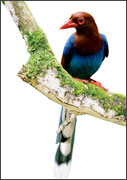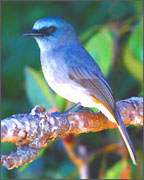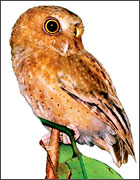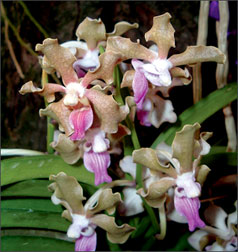|
Are you ready?
Doomsday is closer than you think:
by Sajitha Prematunge

Sri Lanka blue magpie |

Dusky blue flycatcher |

Serendib scops owl |
 |

Asanka’s shrub frog
Pix: Vimukthi Weeratunga |

Anuradhapura Orchid
Pic: Dilup Chandranimal |
Someone told me once that I should stay well away from the "Doomsday
theory" when writing about environmental issues. Although this was meant
well most people don't have the slightest idea that doomsday is closer
than they really think.
The long awaited 2007 Red List of Threatened Fauna and Flora of Sri
Lanka was launched - after a lapse of almost eight years - on November
22 with the honoured presence of Patali Champika Ranawaka, Minister of
Environment and Natural Resources, Udaya Gammanpilla, Chairman, Central
Environmental Authority and many other distinguished guests.
The Red List, based on a chain of researches spanning over three
years, prove that the FUTURE of most Sri Lankan indigenous species of
fauna and flora alike, is indeed BLEAK.
The 2007 Red List of Threatened Fauna and Flora of Sri Lanka is a
collaborative effort by IUCN - The World Conservation Union and the
Ministry of Environment and Natural Resources (MOENR). The research was
funded by the ADB through the Protected Area Management and Wildlife
Conservation and Royal Netherlands Embassy.
Its primary goal is to identify and document the species most in need
of conservation and provide an index of their state of biodiversity,
using global Red List criteria adapted to the regional level. The Red
list classifies species according to their risk of extinction, and the
threatened species are divided in to three categories - Critically
endangered, Endangered and Vulnerable.
Shiranee Yasaratne, Country Representative World Conservation said
that the findings of the Red List would serve as the baseline for the
development and implementation of suitable policies and actions to
conserve threatened species for the future.
Bhathiya Kekulandala, Programme Officer IUCN, in a press briefing
maintained that the previously compiled Red List could not be updated
because a computerized version was never put together. But new data can
now be directly uploaded to the new database, already in the custody of
the Ministry of Environment and Natural Resources.
This database will be available to the public in the near future and
will undoubtedly be a blessing for all researchers in the field of
Environment. The 2007 Red List has many uses. It could be used for
policy formulation and decision making, research, awareness creation and
of course for monitoring purposes.
The theme of the 2007 Red List was 'On the way out' and for many of
our indigenous species it's indeed the case.
In fact one in every two mammals, one in three reptiles, one in five
birds and 675 species of plants are 'on their way out'. Research used
for the compilation of The 2007 Red List, conducted along three
categories - Inland vertebrate fauna, Inland invertebrate fauna and
flowering plants, were based on hard scientific facts.
Among the endemic inland vertebrates in Sri Lanka, the highest number
of threatened species was recorded among the reptiles. Thirty four (12%)
inland vertebrates are critically endangered, that means they run a very
high risk of becoming extinct in the wild if things do not change for
the better soon.
These endemic species are what matters the most as explained by Dr.
Channa Bambaradeniya, Coordinator Species Conservation Unit, IUCN - if
they become extinct from Sri Lanka they would be lost to the rest of the
world.
Among the Inland invertebrates the highest number of threatened
species was recorded among butterflies. Among the 675 threatened plant
species 412 species (61%) are endemic. About 37% are critically
endangered. A higher number of threatened species are recorded from the
orchid family.
 The Geographical distribution of the threatened species show that
most of the recorded species are prominent in Kandy, Ratnapura, Galle,
Martara, Kalutara and Nuwara-Eliya districts. Most of the threatened
fresh water fish species are restricted to rivers such as Nilwala, Kalu,
Kelani, Gin and their tributaries. The Geographical distribution of the threatened species show that
most of the recorded species are prominent in Kandy, Ratnapura, Galle,
Martara, Kalutara and Nuwara-Eliya districts. Most of the threatened
fresh water fish species are restricted to rivers such as Nilwala, Kalu,
Kelani, Gin and their tributaries.
Among these Kelani is extremely polluted and all the others are over
exploited for gem and sand mining using harmful methods. The threatened
fish species are also heavily exploited for commercial purposes.
All these species, plants and animals alike are in grave danger if
habitat degradation is not reversed. Citizens of Colombo may have
noticed that the purple faced leaf monkey has literary disappeared from
Colombo.
It's clear that biodiversity degradation is interlinked with the
development process. Habitat loss is one of the major issues that
threaten species in the wild today. Sri Lanka's annual loss of forest
cover is 33,000 hectares. But in the wet zone this is even higher. Wet
land reclamation, siltation and dumping garbage in wet lands have caused
rapid wet land degradation. Thereby risking the extinction of many wet
land species.
Minister Patali Champika Ranawaka stated that Sri Lanka is found to
be one of the ten countries, in South Asia with the highest consumption
of agro-chemicals. And according to a study conducted by the ministry a
death of an elephant is reported every two days and they are already 'on
the way' to be locally extinct in the wet zone.
Over exploitation of species by way of poaching, human-wildlife
conflict, road kills and commercial trade coupled with natural disasters
add to the list of threats to these highly vulnerable and highly
significant species.
So, you be the judge of how far Doomsday is.....
[email protected] |
